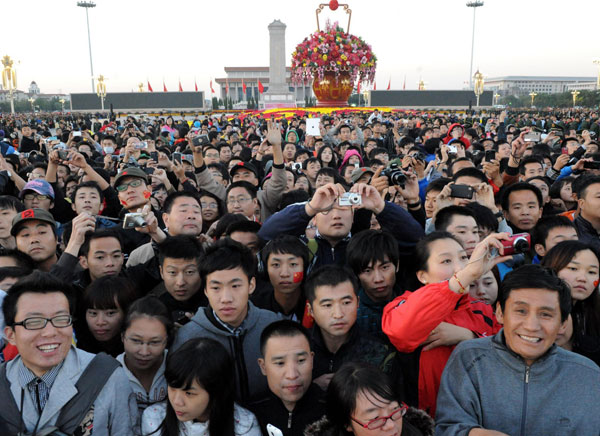Chinese mark National Day
Updated: 2012-10-01 20:30
(Xinhua)
|
||||||||
BEIJING - More than 80,000 people from across China rallied at Tian'anmen Square in the heart of Beijing at daybreak Monday to watch the raising of the national flag.
 |
|
People watch the national flag raising ceremony at the Tian'anmen Square in Beijing, Oct 1, 2012. [Photo/Xinhua] |
The crowd stood in silence when the national anthem was played and the five-star flag was raised on its mast.
Though the ceremony is held every morning, Monday's event drew a larger-than-normal crowd of tourists and local residents who chose to celebrate the National Day at the square.
Monday marks the 63rd founding anniversary of the People's Republic of China.
"I've made money from the Tibetan medicine trade just so I can afford to make this trip with my son," said Chu Rong Je, a Tibetan businessman from Heshui County of Aba Prefecture in Southwest China's Sichuan province.
Chu Rong Je's home county was flattened in the 2008 earthquake. With a government subsidy, his family moved into a new home and their medicine business became prosperous again. "We're grateful the government helped us out during our time of hardship."
Three students from Beijing Sport University hiked more than four hours Sunday night from their campus in the northwest of the city to Tian'anmen Square. "Hiking made the trip feel more like a pilgrimage," said He Yuliang. "We're proud to witness the raising of the flag here."
More than 200 million people have witnessed the flag-raising ceremony at Tian'anmen Square since the ritual began in May, 1991, official figures said.
Love of motherland
A similar ceremony was held by the Huangpu River in Shanghai Monday, attended by about 1,000 young men and women and two patrol ships.
After the flag was raised to the top of the mast, the patrol ships horned and thousands of balloons were let go to highlight the festivity.
In Tibet's regional capital Lhasa, a flag-raising ceremony was held in a square outside the Potala Palace. "Our teacher brought us all here," said Tenzin Nyima, a junior high school student. "We're all very excited, I hope I can come every year."
To watch the national flag going up on the roof of the world was a unique experience for Li Xuelan, a tourist from Wuhan City in central China's Hubei Province. "There's an unexpectedly large crowd," she said. "Here I feel clearly the solidarity between Chinese people of different ethnic groups, and our common love for the motherland."
The newly established city of Sansha in the South China Sea, 2,680 km from Beijing, also witnessed the raising of the national flag at daybreak.
"Great changes have taken place here since I first arrived at the Yongxing Island in August 1978," said Wu Qingzhi, a specialist on tropical aquatic animals. "We're confident the city will become an even better place."
Jiang Teng, one of the soldiers who raised the flag, said he was proud to mark the day in Sansha City. "We have a bigger role to play in guarding this southernmost Chinese city."
Sansha City was created on July 24 on Yongxing Island to administer the Xisha, Zhongsha and Nansha islands and their surrounding waters in the South China Sea.
Meanwhile, the crew on board Haijian 50, one of China's marine surveillance ships, sang the national anthem and waved flags as the ship was patrolling on the East China Sea.
In September this year, ships including Haijian 50 conducted law enforcement and patrol activities around the Diaoyu Islands to assert China's sovereignty.
![A woman visits the Tian'anmen Square in Beijing, Sept 30, 2012. [Photo/Xinhua] Chinese mark National Day](../../attachement/jpg/site1/20121001/d4bed9d5345511d3d1d90b.jpg) |
|
A woman visits the Tian'anmen Square in Beijing, Sept 30, 2012. [Photo/Xinhua] |
Travel rush
Zhang Lecheng, a 30-year-old resident from Zhengzhou, capital of central China's Henan Province, took a newly-opened high speed rail service to Wuhan in Hubei Province on Monday, bringing his wife and parents. The train ride lasted only two hours, compared with 4.5 hours before.
A large number of Chinese people have hit the road during the eight-day holiday that began on Sunday.
The travel rush, plus a new government policy that made most expressways toll free for passenger cars under seven seats, has posed a heavy burden on roads.
Beijing Municipal Commission of Transport estimated 1.7 million vehicles hit the city's expressways Monday, compared with 1.6 million on Sunday.
But congestion eased Monday on most expressways, as cars were no longer requested to halt at toll gates to collect an electric ticket, the commission said.
The practice caused standstills at toll gates on Sunday.

 Relief reaches isolated village
Relief reaches isolated village
 Rainfall poses new threats to quake-hit region
Rainfall poses new threats to quake-hit region
 Funerals begin for Boston bombing victims
Funerals begin for Boston bombing victims
 Quake takeaway from China's Air Force
Quake takeaway from China's Air Force
 Obama celebrates young inventors at science fair
Obama celebrates young inventors at science fair
 Earth Day marked around the world
Earth Day marked around the world
 Volunteer team helping students find sense of normalcy
Volunteer team helping students find sense of normalcy
 Ethnic groups quick to join rescue efforts
Ethnic groups quick to join rescue efforts
Most Viewed
Editor's Picks

|

|

|

|

|

|
Today's Top News
Health new priority for quake zone
Xi meets US top military officer
Japan's boats driven out of Diaoyu
China mulls online shopping legislation
Bird flu death toll rises to 22
Putin appoints new ambassador to China
Japanese ships blocked from Diaoyu Islands
Inspired by Guan, more Chinese pick up golf
US Weekly

|

|







